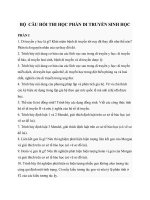Bộ câu hỏi thi chứng chỉ databrick certified data engineer associate version 2 (File 3 question)
Bạn đang xem bản rút gọn của tài liệu. Xem và tải ngay bản đầy đủ của tài liệu tại đây (221.75 KB, 17 trang )
1. Question
Which of the following is true, when building a Databricks SQL dashboard?
A. A dashboard can only use results from one query
B. Only one visualization can be developed with one query result
C. A dashboard can only connect to one schema/Database
D. More than one visualization can be developed using a single query result
E. A dashboard can only have one refresh schedule
2. Question
A newly joined team member John Smith in the Marketing team currently has access read access to
sales tables but does not have access to update the table, which of the following commands help you
accomplish this?
A. GRANT UPDATE ON TABLE table_name TO
B. GRANT USAGE ON TABLE table_name TO
C. GRANT MODIFY ON TABLE table_name TO
D. GRANT UPDATE TO TABLE table_name ON
E. GRANT MODIFY TO TABLE table_name ON
3. Question
A new user who currently does not have access to the catalog or schema is requesting access to the
customer table in sales schema, but the customer table contains sensitive information, so you have
decided to create view on the table excluding columns that are sensitive and granted access to the
view GRANT SELECT ON view_name to but when the user tries to query the view,
gets the error view does not exist. What is the issue preventing user to access the view and how to fix
it?
A. User requires SELECT on the underlying table
B. User requires to be put in a special group that has access to PII data
C. User has to be the owner of the view
D. User requires USAGE privilege on Sales schema
E. User needs ADMIN privilege on the view
4. Question
How do you access or use tables in the unity catalog?
A. schema_name.table_name
B. schema_name.catalog_name.table_name
C. catalog_name.table_name
D. catalog_name.database_name.schema_name.table_name
E. catalog_name.schema_name.table_name
5. Question
How do you upgrade an existing workspace managed table to a unity catalog table?
ALTER TABLE table_name SET UNITY_CATALOG = TRUE
A. Create table catalog_name.schema_name.table_name
B. as select * from hive_metastore.old_schema.old_table
C. Create table table_name as select * from hive_metastore.old_schema.old_table
D. Create table table_name format = UNITY as select * from old_table_name
E. Create or replace table_name format = UNITY using deep clone old_table_name
6. Question
Which of the statements is correct when choosing between lakehouse and Datawarehouse?
A. Traditional Data warehouses have special indexes which are optimized for Machine learning
B. Traditional Data warehouses can serve low query latency with high reliability for BI
workloads
C. SQL support is only available for Traditional Datawarehouse’s, Lakehouses support Python
and Scala
D. Traditional Data warehouses are the preferred choice if we need to support ACID, Lakehouse
does not support ACID.
E. Lakehouse replaces the current dependency on data lakes and data warehouses uses an open
standard storage format and supports low latency BI workloads.
7. Question
Where are Interactive notebook results stored in Databricks product architecture?
A. Data plane
B. Control plane
C. Data and Control plane
D. JDBC data source
E. Databricks web application
8. Question
Which of the following statements are true about a lakehouse?
A. Lakehouse only supports Machine learning workloads and Data warehouses support BI
workloads
B. Lakehouse only supports end-to-end streaming workloads and Data warehouses support
Batch workloads
C. Lakehouse does not support ACID
D. Lakehouse do not support SQL
E. Lakehouse supports Transactions
9. Question
Which of the following SQL command can be used to insert or update or delete rows based on a
condition to check if a row(s) exists?
A. MERGE INTO table_name
B. COPY INTO table_name
C. UPDATE table_name
D. INSERT INTO OVERWRITE table_name
E. INSERT IF EXISTS table_name
10. Question
When investigating a data issue you realized that a process accidentally updated the table, you want
to query the same table with yesterday‘s version of the data so you can review what the prior version
looks like, what is the best way to query historical data so you can do your analysis?
A. SELECT * FROM TIME_TRAVEL(table_name) WHERE time_stamp = ‘timestamp‘
B. TIME_TRAVEL FROM table_name WHERE time_stamp = date_sub(current_date(), 1)
C. SELECT * FROM table_name TIMESTAMP AS OF date_sub(current_date(), 1)
D. DISCRIBE HISTORY table_name AS OF date_sub(current_date(), 1)
E. SHOW HISTORY table_name AS OF date_sub(current_date(), 1)
11. Question
While investigating a data issue, you wanted to review yesterday‘s version of the table using below
command, while querying the previous version of the table using time travel you realized that you are
no longer able to view the historical data in the table and you could see it the table was updated
yesterday based on the table history(DESCRIBE HISTORY table_name) command what could be the
reason why you can not access this data?
SELECT * FROM table_name TIMESTAMP AS OF date_sub(current_date(), 1)
A. You currently do not have access to view historical data
B. By default, historical data is cleaned every 180 days in DELTA
C. A command VACUUM table_name RETAIN 0 was ran on the table
D. Time travel is disabled
E. Time travel must be enabled before you query previous data
12. Question
You have accidentally deleted records from a table called transactions, what is the easiest way to
restore the records deleted or the previous state of the table? Prior to deleting the version of the table
is 3 and after delete the version of the table is 4.
A. RESTORE TABLE transactions FROM VERSION as of 4
B. RESTORE TABLE transactions TO VERSION as of 3
C. INSERT INTO OVERWRITE transactions
SELECT * FROM transactions VERSION AS OF 3
D. MINUS
E. SELECT * FROM transactions
INSERT INTO OVERWRITE transactions
SELECT * FROM transactions VERSION AS OF 4
F. INTERSECT
13. Question
Create a schema called bronze using location ‘/mnt/delta/bronze’, and check if the schema exists
before creating.
A. CREATE SCHEMA IF NOT EXISTS bronze LOCATION ‘/mnt/delta/bronze‘
B. CREATE SCHEMA bronze IF NOT EXISTS LOCATION ‘/mnt/delta/bronze‘
C. if IS_SCHEMA(‘bronze‘): CREATE SCHEMA bronze LOCATION ‘/mnt/delta/bronze‘
D. Schema creation is not available in metastore, it can only be done in Unity catalog UI
E. Cannot create schema without a database
14. Question
How do you check the location of an existing schema in Delta Lake?
A. Run SQL command SHOW LOCATION schema_name
B. Check unity catalog UI
C. Use Data explorer
D. Run SQL command DESCRIBE SCHEMA EXTENDED schema_name
E. Schemas are internally in-store external hive meta stores like MySQL or SQL Server
15. Question
Which of the below SQL commands create a Global temporary view?
A. CREATE OR REPLACE TEMPORARY VIEW view_name
AS SELECT * FROM table_name
B. CREATE OR REPLACE LOCAL TEMPORARY VIEW view_name
AS SELECT * FROM table_name
C. CREATE OR REPLACE GLOBAL TEMPORARY VIEW view_name
AS SELECT * FROM table_name
D. CREATE OR REPLACE VIEW view_name
AS SELECT * FROM table_name
E. CREATE OR REPLACE LOCAL VIEW view_name
AS SELECT * FROM table_name
16. Question
When you drop a managed table using SQL syntax DROP TABLE table_name how does it impact
metadata, history, and data stored in the table?
A. Drops table from meta store, drops metadata, history, and data in storage.
B. Drops table from meta store and data from storage but keeps metadata and history in
storage
C. Drops table from meta store, meta data and history but keeps the data in storage
D. Drops table but keeps meta data, history and data in storage
E. Drops table and history but keeps meta data and data in storage
17. Question
The team has decided to take advantage of table properties to identify a business owner for each
table, which of the following table DDL syntax allows you to populate a table property identifying the
business owner of a table
A. CREATE TABLE inventory (id INT, units FLOAT)
SET TBLPROPERTIES business_owner = ‘supply chain‘
B. CREATE TABLE inventory (id INT, units FLOAT)
TBLPROPERTIES (business_owner = ‘supply chain‘)
C. CREATE TABLE inventory (id INT, units FLOAT)
SET (business_owner = ‘supply chain’)
D. CREATE TABLE inventory (id INT, units FLOAT)
SET PROPERTY (business_owner = ‘supply chain’)
E. CREATE TABLE inventory (id INT, units FLOAT)
SET TAG (business_owner = ‘supply chain’)
18. Question
Data science team has requested they are missing a column in the table called average price, this can
be calculated using units sold and sales amt, which of the following SQL statements allow you to
reload the data with additional column
A. INSERT OVERWRITE sales
SELECT *, salesAmt/unitsSold as avgPrice FROM sales
B. CREATE OR REPLACE TABLE sales
AS SELECT *, salesAmt/unitsSold as avgPrice FROM sales
C. MERGE INTO sales USING (SELECT *, salesAmt/unitsSold as avgPrice FROM sales)
D. OVERWRITE sales AS SELECT *, salesAmt/unitsSold as avgPrice FROM sales
E. COPY INTO SALES AS SELECT *, salesAmt/unitsSold as avgPrice FROM sales
19. Question
You are working on a process to load external CSV files into a delta table by leveraging the COPY INTO
command, but after running the command for the second time no data was loaded into the table
name, why is that?
COPY INTO table_name
FROM ‘dbfs:/mnt/raw/*.csv‘
FILEFORMAT = CSV
A. COPY INTO only works one time data load
B. Run REFRESH TABLE sales before running COPY INTO
C. COPY INTO did not detect new files after the last load
D. Use incremental = TRUE option to load new files
E. COPY INTO does not support incremental load, use AUTO LOADER
20. Question
What is the main difference between the below two commands?
INSERT OVERWRITE table_name
SELECT * FROM table
CREATE OR REPLACE TABLE table_name
AS SELECT * FROM table
A. INSERT OVERWRITE replaces data by default, CREATE OR REPLACE replaces data and Schema
by default
B. INSERT OVERWRITE replaces data and schema by default, CREATE OR REPLACEreplaces data
by default
C. INSERT OVERWRITE maintains historical data versions by default, CREATE OR REPLACEclears
the historical data versions by default
D. INSERT OVERWRITE clears historical data versions by default, CREATE OR REPLACE maintains
the historical data versions by default
E. Both are same and results in identical outcomes
21. Question
Which of the following functions can be used to convert JSON string to Struct data type?
A. TO_STRUCT (json value)
B. FROM_JSON (json value)
C. FROM_JSON (json value, schema of json)
D. CONVERT (json value, schema of json)
E. CAST (json value as STRUCT)
22. Question
You are working on a marketing team request to identify customers with the same information
between two tables CUSTOMERS_2021 and CUSTOMERS_2020 each table contains 25 columns with
the same schema, You are looking to identify rows that match between two tables across all columns,
which of the following can be used to perform in SQL
A. SELECT * FROM CUSTOMERS_2021
UNION
SELECT * FROM CUSTOMERS_2020
B. SELECT * FROM CUSTOMERS_2021
UNION ALL
SELECT * FROM CUSTOMERS_2020
C. SELECT * FROM CUSTOMERS_2021 C1
INNER JOIN CUSTOMERS_2020 C2
ON C1.CUSTOMER_ID = C2.CUSTOMER_ID
D. SELECT * FROM CUSTOMERS_2021
INTERSECT
SELECT * FROM CUSTOMERS_2020
E. SELECT * FROM CUSTOMERS_2021
EXCEPT
SELECT * FROM CUSTOMERS_2020
23. Question
You are looking to process the data based on two variables, one to check if the department is supply
chain and second to check if process flag is set to True
A. if department = “supply chain” & process:
B. if department == “supply chain” && process:
C. if department == “supply chain” & process == TRUE:
D. if department == “supply chain” & if process == TRUE:
E. if department == “supply chain“ and process:
24. Question
You were asked to create a notebook that can take department as a parameter and process the data
accordingly, which is the following statements result in storing the notebook parameter into a python
variable
A. SET department = dbutils.widget.get(“department“)
B. ASSIGN department == dbutils.widget.get(“department“)
C. department = dbutils.widget.get(“department“)
D. department = notebook.widget.get(“department“)
E. department = notebook.param.get(“department“)
25. Question
Which of the following statements can successfully read the notebook widget and pass the python
variable to a SQL statement in a Python notebook cell?
A. order_date = dbutils.widgets.get(“widget_order_date“)
spark.sql(f“SELECT * FROM sales WHERE orderDate = ‘f{order_date }‘“)
B. order_date = dbutils.widgets.get(“widget_order_date“)
spark.sql(f“SELECT * FROM sales WHERE orderDate = ‘order_date‘ “)
C. order_date = dbutils.widgets.get(“widget_order_date“)
spark.sql(f”SELECT * FROM sales WHERE orderDate = ‘${order_date }‘ “)
D. order_date = dbutils.widgets.get(“widget_order_date“)
spark.sql(f“SELECT * FROM sales WHERE orderDate = ‘{order_date}‘ “)
E. order_date = dbutils.widgets.get(“widget_order_date“)
spark.sql(“SELECT * FROM sales WHERE orderDate = order_date“)
26. Question
The below spark command is looking to create a summary table based customerId and the number of
times the customerId is present in the event_log delta table and write a one-time micro-batch to a
summary table, fill in the blanks to complete the query.
spark._________
.format(“delta“)
.table(“events_log“)
.groupBy(“customerId“)
.count()
._______
.format(“delta“)
.outputMode(“complete“)
.option(“checkpointLocation“, “/tmp/delta/eventsByCustomer/_checkpoints/“)
.trigger(______)
.table(“target_table“)
A. writeStream, readStream, once
B. readStream, writeStream, once
C. writeStream, processingTime = once
D. writeStream, readStream, once = True
E. readStream, writeStream, once = True
27. Question
You would like to build a spark streaming process to read from a Kafka queue and write to a Delta
table every 15 minutes, what is the correct trigger option
A. trigger(“15 minutes“)
B. trigger(process “15 minutes“)
C. trigger(processingTime = 15)
D. trigger(processingTime = “15 Minutes“)
E. trigger(15)
28. Question
Which of the following scenarios is the best fit for the AUTO LOADER solution?
A. Efficiently process new data incrementally from cloud object storage
B. Incrementally process new streaming data from Apache Kafa into delta lake
C. Incrementally process new data from relational databases like MySQL
D. Efficiently copy data from data lake location to another data lake location
E. Efficiently move data incrementally from one delta table to another delta table
29. Question
You had AUTO LOADER to process millions of files a day and noticed slowness in load process, so you
scaled up the Databricks cluster but realized the performance of the Auto loader is still not improving,
what is the best way to resolve this.
A. AUTO LOADER is not suitable to process millions of files a day
B. Setup a second AUTO LOADER process to process the data
C. Increase the maxFilesPerTrigger option to a sufficiently high number
D. Copy the data from cloud storage to local disk on the cluster for faster access
E. Merge files to one large file
30. Question
The current ELT pipeline is receiving data from the operations team once a day so you had setup an
AUTO LOADER process to run once a day using trigger (Once = True) and scheduled a job to run once
a day, operations team recently rolled out a new feature that allows them to send data every 1 min,
what changes do you need to make to AUTO LOADER to process the data every 1 min.
A. Convert AUTO LOADER to structured streaming
B. Change AUTO LOADER trigger to .trigger(ProcessingTime = “1 minute“)
C. Setup a job cluster run the notebook once a minute
D. Enable stream processing
E. Change AUTO LOADER trigger to (“1 minute“)
31. Question
What is the purpose of the bronze layer in a Multi-hop Medallion architecture?
A. Copy of raw data, easy to query and ingest data for downstream processes.
B. Powers ML applications
C. Data quality checks, corrupt data quarantined
D. Contain aggregated data that is to be consumed into Silver
E. Reduces data storage by compressing the data
32. Question
What is the purpose of the silver layer in a Multi hop architecture?
A. Replaces a traditional data lake
B. Efficient storage and querying of full, unprocessed history of data
C. Eliminates duplicate data, quarantines bad data
D. Refined views with aggregated data
E. Optimized query performance for business-critical data
33. Question
What is the purpose of gold layer in Multi hop architecture?
A. Optimizes ETL throughput and analytic query performance
B. Eliminate duplicate records
C. Preserves grain of original data, without any aggregations
D. Data quality checks and schema enforcement
E. Optimized query performance for business-critical data
34. Question
The Delta Live Tables Pipeline is configured to run in Development mode using the Triggered Pipeline
Mode. what is the expected outcome after clicking Start to update the pipeline?
A. All datasets will be updated once and the pipeline will shut down. The compute resources will
be terminated
B. All datasets will be updated at set intervals until the pipeline is shut down. The compute
resources will be deployed for the update and terminated when the pipeline is stopped
C. All datasets will be updated at set intervals until the pipeline is shut down. The compute
resources will persist after the pipeline is stopped to allow for additional development and
testing
D. All datasets will be updated once and the pipeline will shut down. The compute resources will
persist to allow for additional development and testing
E. All datasets will be updated continuously and the pipeline will not shut down. The compute
resources will persist with the pipeline
35. Question
The Delta Live Table Pipeline is configured to run in Production mode using the continuous Pipeline
Mode. what is the expected outcome after clicking Start to update the pipeline?
A. All datasets will be updated once and the pipeline will shut down. The compute resources will
be terminated
B. All datasets will be updated at set intervals until the pipeline is shut down. The compute
resources will be deployed for the update and terminated when the pipeline is stopped
C. All datasets will be updated at set intervals until the pipeline is shut down. The compute
resources will persist after the pipeline is stopped to allow for additional testing
D. All datasets will be updated once and the pipeline will shut down. The compute resources will
persist to allow for additional testing
E. All datasets will be updated continuously and the pipeline will not shut down. The compute
resources will persist with the pipeline
36. Question
You are working to set up two notebooks to run on a schedule, the second notebook is dependent on
the first notebook but both notebooks need different types of compute to run in an optimal fashion,
what is the best way to set up these notebooks as jobs?
A. Use DELTA LIVE PIPELINES instead of notebook tasks
B. A Job can only use single cluster, setup job for each notebook and use job dependency to link
both jobs together
C. Each task can use different cluster, add these two notebooks as two tasks in a single job with
linear dependency and modify the cluster as needed for each of the tasks
D. Use a single job to setup both notebooks as individual tasks, but use the cluster API to setup
the second cluster before the start of second task
E. Use a very large cluster to run both the tasks in a single job
37. Question
You are tasked to set up a set notebook as a job for six departments and each department can run the
task parallelly, the notebook takes an input parameter dept number to process the data by
department, how do you go about to setup this up in job?
A. Use a single notebook as task in the job and use dbutils.notebook.run to run each notebook
with parameter in a different cell
B. A task in the job cannot take an input parameter, create six notebooks with hardcoded dept
number and setup six tasks with linear dependency in the job
C. A task accepts key-value pair parameters, creates six tasks pass department number as
parameter foreach task with no dependency in the job as they can all run in parallel.
D. A parameter can only be passed at the job level, create six jobs pass department number to
each job with linear job dependency
E. A parameter can only be passed at the job level, create six jobs pass department number to
each job with no job dependency
38. Question
You are asked to setup two tasks in a databricks job, the first task runs a notebook to download the
data from a remote system, and the second task is a DLT pipeline that can process this data, how do
you plan to configure this in Jobs UI
A. Single job cannot have a notebook task and DLT Pipeline task, use two different jobs with
linear dependency.
B. Jobs UI does not support DTL pipeline, setup the first task using jobs UI and setup the DLT to
run in continuous mode.
C. Jobs UI does not support DTL pipeline, setup the first task using jobs UI and setup the DLT to
run in trigger mode.
D. Single job can be used to setup both notebook and DLT pipeline, use two different tasks with
linear dependency.
E. Add first step in the DLT pipeline and run the DLT pipeline as triggered mode in JOBS UI
39. Question
You are asked to set up an alert to notify in an email every time a KPI indicater increases beyond a
threshold value, team also asked you to include the actual value in the alert email notification.
A. Use notebook and python code to run every minute, using python variables to capture send
the information in an email
B. Setup an alert but use the default template to notify the message in email’s subject
C. Setup an alert but use the custom template to notify the message in email’s subject
D. Use the webhook destination instead so alert message can be customized
E. Use custom email hook to customize the message
40. Question
Operations team is using a centralized data quality monitoring system, a user can publish data quality
metrics through a webhook, you were asked to develop a process to send messages using a webhook
if there is atleast one duplicate record, which of the following approaches can be taken to integrate an
alert with current data quality monitoring system
A. Use notebook and Jobs to use python to publish DQ metrics
B. Setup an alert to send an email, use python to parse email, and publish a webhook message
C. Setup an alert with custom template
D. Setup an alert with custom Webhook destination
E. Setup an alert with dynamic template
41. Question
You are currently working with the application team to setup a SQL Endpoint point, once the team
started consuming the SQL Endpoint you noticed that during peak hours as the number of concurrent
users increases you are seeing degradation in the query performance and the same queries are
taking longer to run, which of the following steps can be taken to resolve the issue?
A. They can turn on the Serverless feature for the SQL endpoint.
B. They can increase the maximum bound of the SQL endpoint’s scaling range.
C. They can increase the cluster size(2X-Small to 4X-Large) of the SQL endpoint.
D. They can turn on the Auto Stop feature for the SQL endpoint.
E. They can turn on the Serverless feature for the SQL endpoint and change the Spot Instance
Policy from “Cost optimized” to “Reliability Optimized.”
42. Question
The data engineering team is using a bunch of SQL queries to review data quality and monitor the ETL
job every day, which of the following approaches can be used to set up a schedule and automate this
process?
A. They can schedule the query to run every 1 day from the Jobs UI
B. They can schedule the query to refresh every 1 day from the query’s page in Databricks SQL.
C. They can schedule the query to run every 12 hours from the Jobs UI.
D. They can schedule the query to refresh every 1 day from the SQL endpoint’s page in
Databricks SQL.
E. They can schedule the query to refresh every 12 hours from the SQL endpoint’s page in
Databricks SQL
43. Question
In order to use Unity catalog features, which of the following steps needs to be taken on
managed/external tables in the Databricks workspace?
A. Enable unity catalog feature in workspace settings
B. Migrate/upgrade objects in workspace managed/external tables/view to unity catalog
C. Upgrade to DBR version 15.0
D. Copy data from workspace to unity catalog
E. Upgrade workspace to Unity catalog
44. Question
What is the top-level object in unity catalog?
A. Catalog
B. Table
C. Workspace
D. Database
E. Metastore
45. Question
One of the team members Steve who has the ability to create views, created a new view called
regional_sales_vw on the existing table called sales which is owned by John, and the second team
member Kevin who works with regional sales managers wanted to query the data in
regional_sales_vw, so Steve granted the permission to Kevin using command
GRANT VIEW, USAGE ON regional_sales_vw to but Kevin is still unable to access
the view?
A. Kevin needs select access on the table sales
B. Kevin needs owner access on the view regional_sales_vw
C. Steve is not the owner of the sales table
D. Kevin is not the owner of the sales table
E. Table access control is not enabled on the table and view
46. Question
Kevin is the owner of the schema sales, Steve wanted to create new table in sales schema called
regional_sales so Kevin grants the create table permissions to Steve. Steve creates the new table
called regional_sales in sales schema, who is the owner of the table regional_sales
A. Kevin is the owner of sales schema, all the tables in the schema will be owned by Kevin
B. Steve is the owner of the table
C. By default ownership is assigned DBO
D. By default ownership is assigned to DEFAULT_OWNER
E. Kevin and Smith both are owners of table
47. Question
You were asked to setup a new all-purpose cluster, but the cluster is unable to start which of the
following steps do you need to take to identify the root cause of the issue and the reason why the
cluster was unable to start?
A. Check the cluster driver logs
B. Check the cluster event logs
C. Workspace logs
D. Storage account
E. Data plane
48. Question
Which of the following developer operations in CI/CD flow can be implemented in Databricks Repos?
A. Delete branch
B. Trigger Databricks CICD pipeline
C. Commit and push code
D. Create a pull request
E. Approve the pull request
49. Question
You noticed that a team member started using an all-purpose cluster to develop a notebook and used
the same all-purpose cluster to set up a job that can run every 30 mins so they can update underlying
tables which are used in a dashboard. What would you recommend for reducing the overall cost of
this approach?
A. Reduce the size of the cluster
B. Reduce the number of nodes and enable auto scale
C. Enable auto termination after 30 mins
D. Change the cluster all-purpose to job cluster when scheduling the job
E. Change the cluster mode from all-purpose to single-mode
50. Question
Which of the following commands can be used to run one notebook from another notebook?
A. notebook.utils.run(“full notebook path“)
B. execute.utils.run(“full notebook path“)
C. dbutils.notebook.run(“full notebook path“)
D. only job clusters can run notebook
E. spark.notebook.run(“full notebook path“)









